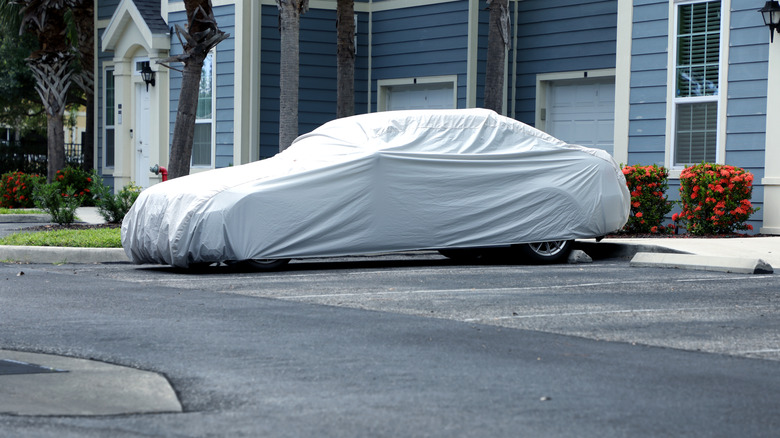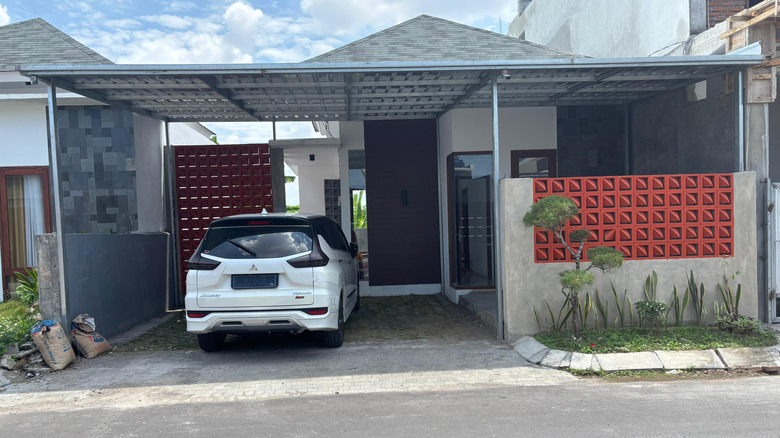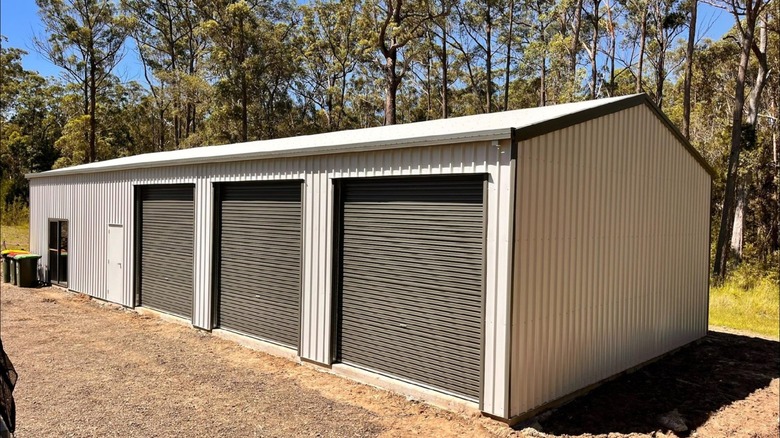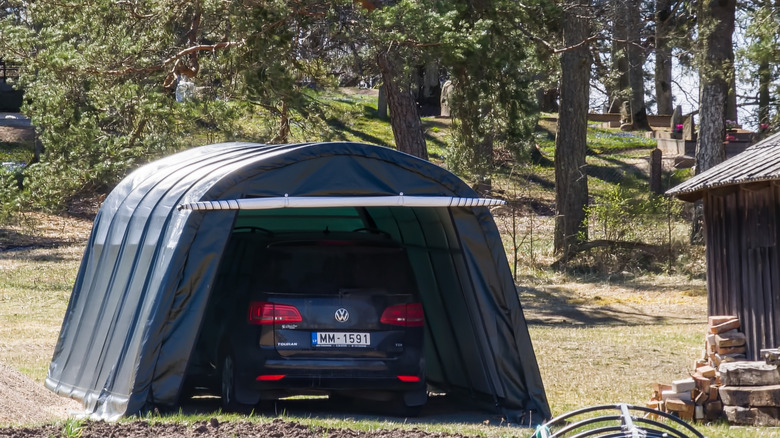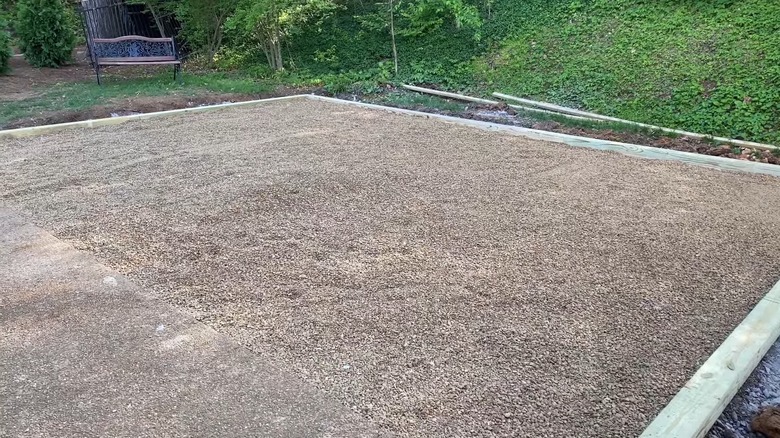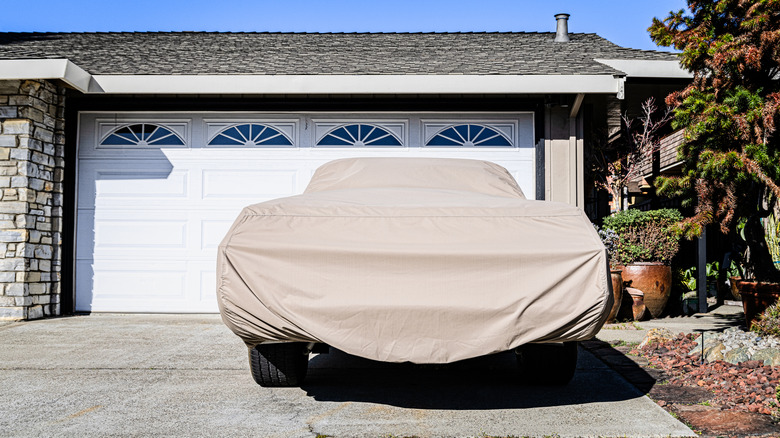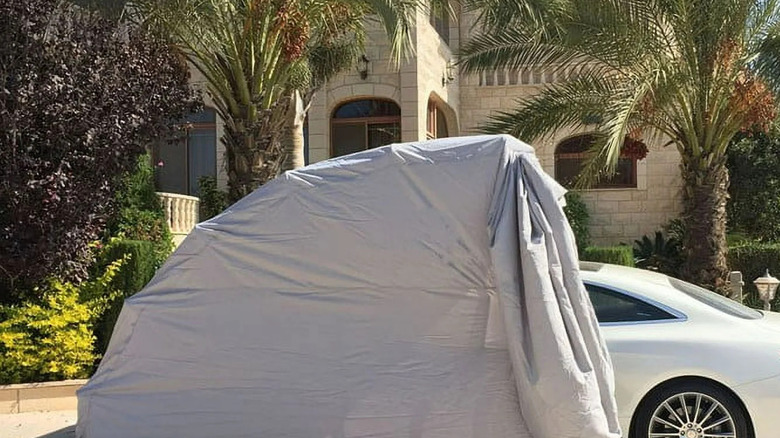Garage Alternatives That Don't Involve Construction
We may receive a commission on purchases made from links.
Picture this: It's 8 p.m. and your kids are waiting for you at the dinner table. But you're circling the block for the third time, looking for parking. While a dedicated structure would take care of this pesky issue in a jiffy, you might not want to spend nearly $30,000 on average to build a garage. The lengthy permit process (depending on where you live), contractor management, and the inevitable disruption to your daily life will further complicate things. Add in the volatility of material prices, and it's not exactly a simple project.
Fortunately, more practical solutions such as carports, portable garages, and versatile storage shelters can address these challenges head-on. High-quality options can withstand winds up to 170 miles per hour and snow loads of over 30 pounds per square foot — comparable protection to traditional structures at a fraction of the cost. You can build these quickly (sometimes within hours instead of weeks) and reconfigure them as your needs change. Better yet, if you relocate annually, you can take many of these options with you. Excited to learn more? Here are the best cost-effective, time-saving, and eco-friendly garage alternatives.
Carports are long-lasting and budget-friendly
A carport is an open-sided structure with a roof that offers your vehicle protection from elements, like sunlight, snow, and rainfall. Plus, modern metal options require minimal maintenance. These freestanding or attached structures typically consist of a roof supported by posts or beams and is open on one or more sides. They make for a good alternative to garages because you can assemble them yourself. Arrow's 29-Gauge Carport is a good example.
Plus, carports allow customizations. For instance, you could add solar panels to your model and turn it into an energy-producing unit. Even better, if you have multiple vehicles, you can add enclosed partitions or sections to create distinct spots for each. The best part, though? The customizations are minimal, quick, and easy to install using DIY kits. Weigh all your creative carport options to make the most of your parking space.
Since carports can cost anywhere between $300 and $25,000, consider the size of your vehicle(s) and what's in your budget. You also want to examine the space available to choose between a freestanding and an attached unit. Once you have your carport, select a level area and clear any debris to ready the spot. Next, assemble the unit's framework. Start with the main support post and, then, add the roof panels and sidewalls (if you have them). Be sure to check your local building codes and follow the manufacturer's specifications for seamless assembly.
Car sheds are versatile and quick to put together
A car shed is a more enclosed or robust structure compared to a carport. It provides shelter for vehicles and typically consists of a roof supported by posts or frames, offering protection from rain, snow, and debris. Car sheds can come in various designs and sizes, offering some flexibility to match different needs and property layouts. You can choose from metal sheds, canopy sheds made from durable UV-resistant materials, or wooden sheds for an aesthetically pleasing look. You can also go for structural modifications like adjustable height, expandable width, and modular designs for future extensions.
As compared to traditional garages, car sheds are less expensive to build or purchase due to simpler construction and fewer materials. First, figure out where exactly you'll put it and ensure a strong foundation for your car shed by leveling the section and removing debris. When it comes to assembly, don't worry, as many prefabricated kits are designed with ease of assembly in mind. Parts are often pre-cut and pre-drilled, and you can bolt or screw them together following the manufacturer's instructions and save up on labor costs. That being said, this will be easier for individuals with some DIY experience and understanding of basic tools.
Get effective weather protection with portable garage kits
Portable garages are temporary or semi-permanent structures designed to provide shelter to vehicles, though you can keep your other belongings in them, too. They come in different designs and sizes, from inflatable garages to prefabricated porta cabins. Inflatable garages are cost-effective and easy to relocate. However, other portable garages are constructed with a metal frame (usually advanced industrial-grade steel or aluminum) and are covered with a durable fabric like UV-stable polyethylene-based materials. This ensures the structure experiences less degradation when it's exposed to sunlight.
As the name suggests, these structures are also flexible and require less maintenance. Depending on the type of portable garage you choose, you can also get added advantages. For example, a steel-framed structure provides long-lasting protection to your vehicles from robust wind and snow. However, they require bolts and screws, making their assembly a time-consuming process if you don't have tools every homeowner should have. On the other hand, inflatable garages are lightweight and quick to set up and take down.
These garages can cost between a few hundred for an inflatable one and tens of thousands for a framed one, depending on the size of your kit. When setting up these garages, always pick a level area and clear it of debris. Then, create a stable foundation using a gravel or concrete pad. Review the instruction manual carefully and organize the tools before assembling. Once you have them, follow the manufacturer's instructions to begin assembling your portable garage.
Parking pads are budget-friendly and don't pull focus from your house's exterior design
Parking pads are a no-brainer when you're looking for garage alternatives. These are designated areas of a property constructed with a durable surface material intended for parking vehicles. Unlike a garage or carport, a parking pad does not offer overhead or enclosed protection. However, it helps you maintain the aesthetics of your house's architecture and design. It also gives you an option to park your car when your street is otherwise full.
Parking pads are less expensive than garages and car sheds. They cost as low as about $2.5 to $7 per square foot, including the cost of materials and labor. You can get the material from home improvement stores or concrete and asphalt companies and hire general contractors to build one. But don't worry — contractors and laborers can still wrap up the paving process in a day or two, unlike a traditional garage.
Essentially, you'll notice a cost difference when considering whether to go for concrete or asphalt. Concrete is a durable and long-lasting option but comparatively more expensive than asphalt. However, since asphalt is more flexible, it's also more economical. So, consider your requirements before you invest in one. You could also go for the DIY route and get a gravel pad. Then, layer crushed stone to create a parking area. Drainage is also an important consideration. In the case of gravel, water drains easily, but concrete and asphalt can crack if not properly poured and reinforced.
Use car covers to protect your vehicle's paint job
Car covers are a simple and super-cost-effective garage alternative. These protective sheets are made of various materials, including fabric, plastic, or a combination of the two, and are placed over a vehicle to shield it from environmental elements. But don't underestimate car covers just because they're so simple. While they don't provide fully enclosed and secure storage, they're effective at protecting your automobiles against dust, dirt, rain, snow, UV rays, tree sap, bird droppings, and minor scratches.
Different materials of the cover offer varying levels of protection against elements, so consider your primary threats when buying. For example, UV-resistant covers are good for protecting against sun damage, and padded or fleece-lined covers can offer extra protection against surface-level dings from things like hail. You can even order custom-made car covers tailored to your exact vehicle dimensions and desired features, with many manufacturers offering security features like cable locks to prevent theft.
Car covers are more affordable than conventional garages, ranging from around $50 to a few hundred dollars. For example, the EzyShade 10-Layer Car Cover has options to fit a wide range of models and runs about $75. And, of course, they are incredibly easy to use. Simply drape it over your vehicle. Be sure to secure them — many covers come with elasticized hems or straps with buckles to secure them underneath the vehicle. For custom-fit car covers, order them from specialty car cover manufacturers. But if you're on a tight budget, you can even repurpose your old tarps into a makeshift car cover.
Retractable tents are ideal for people who want fast and easy shelter
Retractable tents are portable shelters designed with a folding or telescoping structure that makes them easier to expand and collapse. They're popular as alternatives to traditional garages due to their portability, ease of use, and protective features. Better yet, they can fold down into a much smaller package for storage or transport, and then expand to cover a car. They're made using a rounded frame and sturdy and waterproof materials like nylon.
You can get a simple tent for a few hundred dollars, or a more complex cover with automated setup for a few thousand, such as the Semi-Automatic Car Tent. The operating instructions may vary significantly based on the specific one you choose. So, read the manufacturer's manual to set up your model. Generally, you want to pick a relatively flat spot large enough for the tent and your vehicle. Ensure all of the connections are secure, the cover is taut, and the structure is stable before using it.
